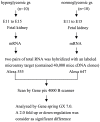Hyperglycemia: GDNF-EGR1 pathway target renal epithelial cell migration and apoptosis in diabetic renal embryopathy
- PMID: 23468876
- PMCID: PMC3585314
- DOI: 10.1371/journal.pone.0056731
Hyperglycemia: GDNF-EGR1 pathway target renal epithelial cell migration and apoptosis in diabetic renal embryopathy
Abstract
Maternal hyperglycemia can inhibit morphogenesis of ureteric bud branching, Glial cell line-derived neurotrophilic factor (GDNF) is a key regulator of the initiation of ureteric branching. Early growth response gene-1 (EGR-1) is an immediate early gene. Preliminary study found EGR-1 persistently expressed with GDNF in hyperglycemic environment. To evaluate the potential relationship of hyperglycemia-GDNF-EGR-1 pathway, in vitro human renal proximal tubular epithelial (HRPTE) cells as target and in vivo streptozotocin-induced mice model were used. Our in vivo microarray, real time-PCR and confocal morphological observation confirmed apoptosis in hyperglycemia-induced fetal nephropathy via activation of the GDNF/MAPK/EGR-1 pathway at E12-E15. Detachment between ureteric branch and metanephrons, coupled with decreasing number and collapse of nephrons on Day 1 newborn mice indicate hyperglycemic environment suppress ureteric bud to invade metanephric rudiment. In vitro evidence proved that high glucose suppressed HRPTE cell migration and enhanced GDNF-EGR-1 pathway, inducing HRPTE cell apoptosis. Knockdown of EGR-1 by siRNA negated hyperglycemic suppressed GDNF-induced HRPTE cells. EGR-1 siRNA also reduced GDNF/EGR-1-induced cRaf/MEK/ERK phosphorylation by 80%. Our findings reveal a novel mechanism of GDNF/MAPK/EGR-1 activation playing a critical role in HRPTE cell migration, apoptosis and fetal hyperglycemic nephropathy.
Conflict of interest statement
Figures




References
-
- Eriksson UJ (1995) The pathogenesis of congenital malformations in diabetic pregnancy. Diabetes Metab Rev 11: 63–82. - PubMed
-
- Suhoene L, Hiilesmaa V, Termo K (2000) Glycaemic control during early pregnancy and fetal malformations in women with type I diabetes mellitus. Diabetologia 43: 79–82. - PubMed
-
- Kitzmiller JL, Gavin LA, Gin Gd, Jovanovic-Peterson L, Main EK, et al. (1991) Preconception care of diabetes: Glycemic control prevents congenital anomalies. JAMA 265: 731–736. - PubMed
-
- Lynch Sa, Wright C (1997) Sirenomelia, limb reduction defects, cardiovascular malformation, renal agenesis in an infant born to a diabetic mother. Clin Dysmorphol 6: 75–80. - PubMed
Publication types
MeSH terms
Substances
LinkOut - more resources
Full Text Sources
Other Literature Sources
Medical
Molecular Biology Databases
Research Materials
Miscellaneous

